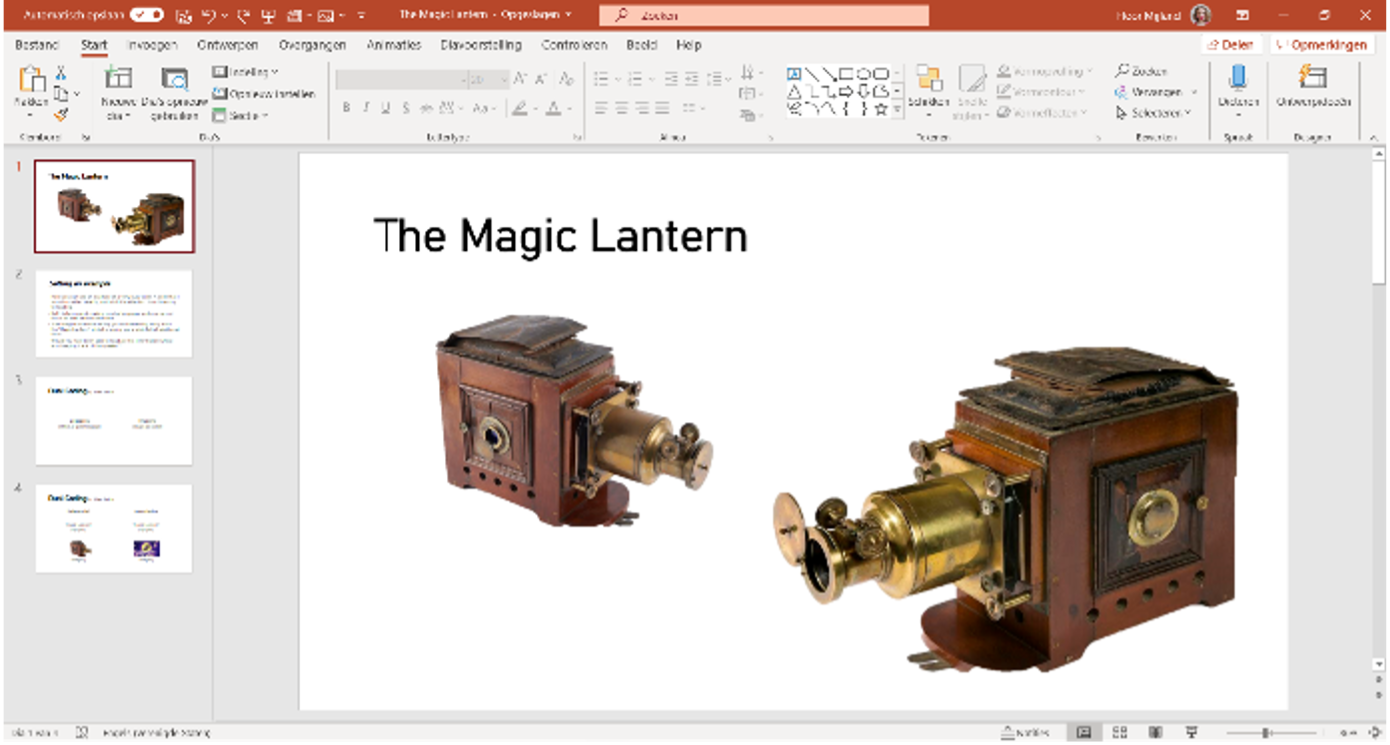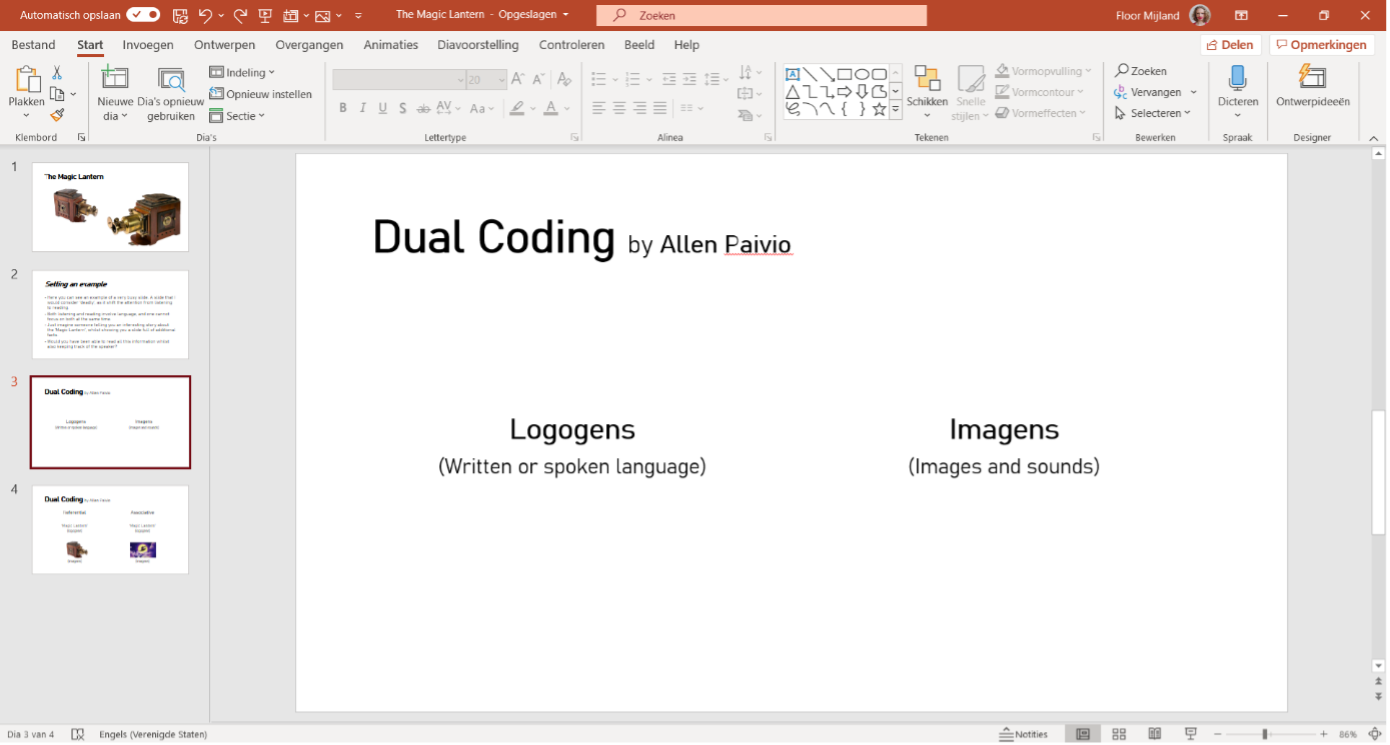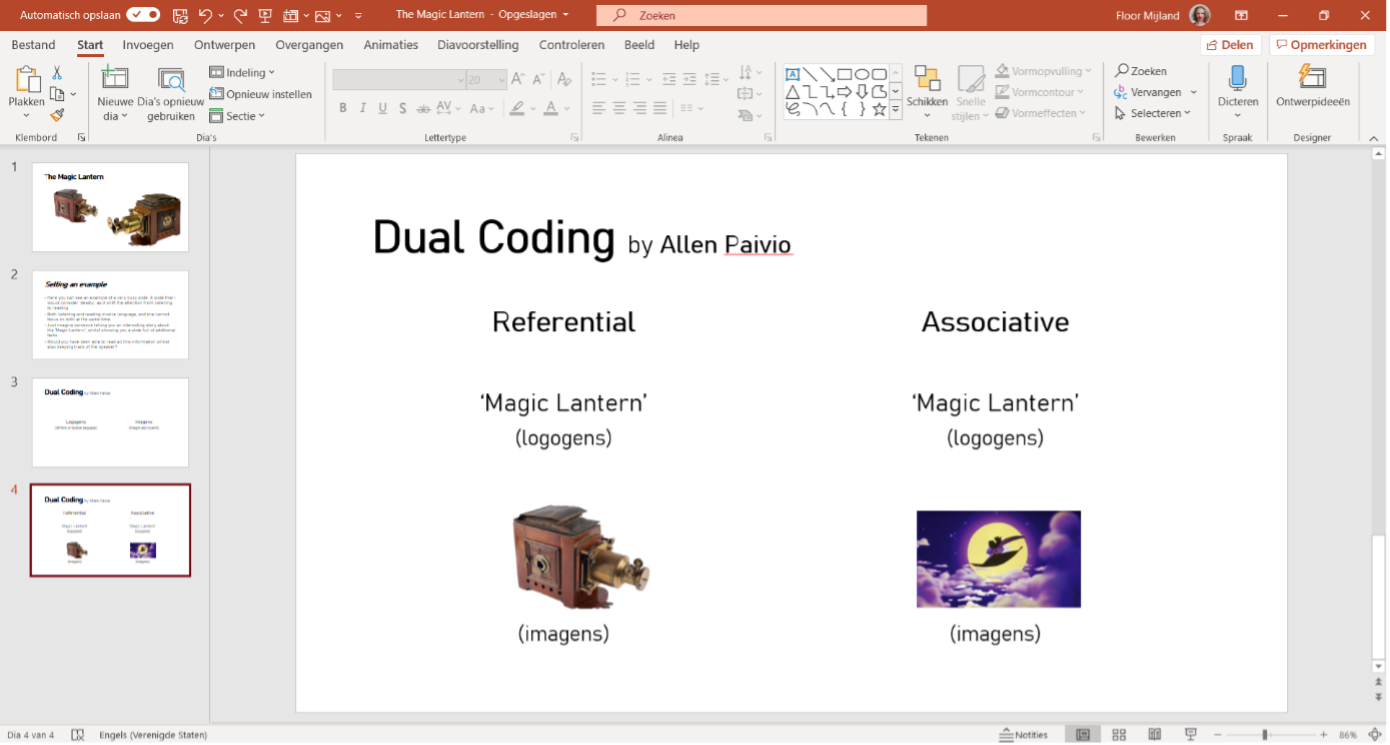Seminar Blogs
“Magic Lanterns, PowerPoints and Dual Coding” – Floor Mijland
It almost sounds like an item from a children’s book: ‘The Magic Lantern’. It evokes images of far off places, daring sword fights and magic carpet rides. In a way, these mental images are not far off. When listening to Frank Kessler, Jamilla Notebaard and Nico de Klerk in the Transmission in Motion seminar of February 24th, it becomes clear that visual aids, such as the magic lantern, indeed enable teachers to show their learners wonderous images. Such images change the modalities of knowledge transmission, engaging the audience and making a lasting impression.

Inspired by the seminar, I thought of a common contemporary version of the magic lantern: the PowerPoint. As the name suggests, this medium should aid its user to make a powerful point. Unfortunately, in my experience, this is not always the case. In many lectures, slides are filled with text, with a lecturer speaking over them, adding even more information.
To be fair: putting text on slides is not per definition problematic. When verbally citing an author, it is useful to put the citation on a slide. Move over, slides with pointers or sentences appearing consecutively can also function as a visual aid. The kind of text-heavy PowerPoints I am referring to, are those used by lecturers who state: ‘You don’t have to write all of this down, the slides will be shared after the lecture’. So why bother using them in your lecture at all?

The reason I think text-heavy slides do not work well as a modality of knowledge transmission is related to the concept of ‘dual coding’, as introduced by psychology professor Allen Paivio. In his theory, Paivio suggests that we have two distinct subsystems that contribute to cognition: one for language and verbal information, and the other for images and non-verbal information. According to Paivio, this explains why humans can simultaneously deal with verbal entities, such as spoken or written words, and with nonverbal objects and events, such as images and sounds not related to speech. Paivio uses the term ‘logogens’ to refer to verbal entities and the term ‘imagens’ for non-verbal entities.

Logogens and imagens can be connected in two ways: referential and associative. In referential connections, we can connect names to pictures, or put images to words, e.g., connecting the name ‘magic lantern’ to its image. Connecting ‘the magic lantern’ and ‘a magic carpet ride’ is associative. References and associations ultimately become entangled in a complex network of human memory (Learning Theories 2012).

Paivio’s conception of dual coding has several practical uses in educational settings, think of supporting difficult verbal concepts with more concrete visual images. However, an important consequence of Paivio’s theory is that using written and spoken language simultaneously causes conflict. Full-text PowerPoint slides impose both written and spoken text on the reader, and, being both logogentic, they obstruct the comprehension process. Here, the learner has to choose what to pay attention to: the slides or the speaker. This means either the spoken information or the written information gets lost in translation.
Circling back to the magic lantern, and the research done by Kessler, Notebaard, and De Klerk, I would like to emphasize one of the points they also made: the importance of the teacher in the transferal of knowledge. It is the teacher who decides what, where and when additional information is added. When using educational aids, may it be a magic lantern or a PowerPoint, the most important thing to consider is how you use it. And with regard to the PowerPoint, I would like to suggest using it with care, always considering which cognitive systems you want to appeal to, and whether or not they may be conflicting.
References
- Utrecht University. 2021. “Transmission in Motion Seminar (2020-2021): “Knowledge Transmission with the Lantern” – Frank Kessler, Jamilla Notebaard and Nico de Klerk (Utrecht University).” Transmission in Motion (blog), Utrecht University. February 24th, 2021. https://transmissioninmotion.sites.uu.nl/transmission-in-motion-seminar-2020-2021-knowledge-transmission-with-the-lantern-frank-kessler-jamilla-notebaard-dulce-da-rocha-goncalves-and-nico-de-klerk-utrecht-university/.
- Learning Theories. 2012. “Dual Coding Theory”. Last modified: January 12th, 2012, 11:42. https://learning-theories.org/doku.php?id=learning_theories:dual_coding_theory.
*Image credits:
Mijland, Floor W. 2021. March 4th, 2021. The Magic Lantern, Slide 1. Digital image. Private Collection. Based on: Science Museum. ‘Magic lantern projector with seven boxes of slides, made by Aubrey Franks Ltd, Manchester, c.1890’. Science Museum Group. https://collection.sciencemuseumgroup.org.uk/objects/co8417489/magic-lantern-projector-with-s-lantern-projector.
Mijland, Floor W. 2021. March 4th, 2021. The Magic Lantern, Slide 2. Digital image. Private collection.
Mijland, Floor W. 2021. March 4th, 2021. The Magic Lantern, Slide 3. Digital image. Private collection.
Mijland, Floor W. 2021. March 4th, 2021. The Magic Lantern, Slide 4. Digital image. Private collection. Based on: Science Museum. ‘Magic lantern projector with seven boxes of slides, made by Aubrey Franks Ltd, Manchester, c.1890’. Science Museum Group. https://collection.sciencemuseumgroup.org.uk/objects/co8417489/magic-lantern-projector-with-s-lantern-projector. Indielondon. ‘Magic carpet ride’. Indie London. http://www.indielondon.co.uk/images/26446.jpg.

